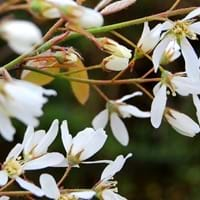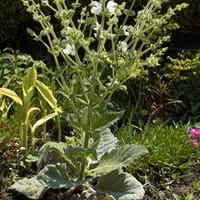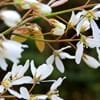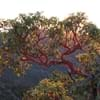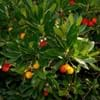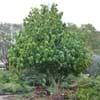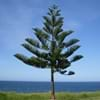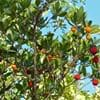What is
Life Span
Perennial
Biennial
Type
Tree
Herbs, Shrub
Origin
United States, Northeastern United States, Mid-Atlantic United States, Southeastern United States, Central United States, South-Central United States
Mediterranean, Northern Africa
Types
shadbush, wild plum
Not Available
Number of Varieties
20
99+
Not Available
Habitat
Swamps, Thickets, Woods
Temperate Regions
USDA Hardiness Zone
4-9
5-8
AHS Heat Zone
9-1
8 - 5
Sunset Zone
2a, 2b, 3a, 3b, 4, 5, 6
21,22
Habit
Oval or Rounded
Rosette/Stemless
Information
Plant Size
Minimum Height
610.00 cm
99+
10.20 cm
99+
Minimum Width
300.00 cm
99+
50.80 cm
99+
Plant Color
Flower Color
White
White
Flower Color Modifier
Bicolor
Bicolor
Fruit Color
Red, Violet, Plum
Not Available
Leaf Color in Spring
Green, Gray Green
Silver
Leaf Color in Summer
Green
Silver
Leaf Color in Fall
Yellow, Red, Orange, Orange Red
Silver
Leaf Color in Winter
Not Available
Light Green
Shape
Leaf Shape
Oval
Oval with a pointed tip and fine teeth along their edges
Thorns
No
No
Season
Plant Season
Spring, Summer, Fall
Spring, Summer, Fall
Growing Conditions
Sunlight
Full Sun, Partial Sun
Full Sun, Partial Sun
Growth Rate
Medium
Fast
Type of Soil
Clay, Loam, Sand
Clay, Loam, Sand
The pH of Soil
Acidic, Neutral, Alkaline
Acidic, Neutral, Alkaline
Soil Drainage
Average
Well drained
Bloom Time
Spring
Summer, Late Summer, Early Fall
Repeat Bloomer
No
No
Tolerances
Not Available
Not Available
Care
Where to Plant?
Ground
Ground, Pot
How to Plant?
Grafting, Seedlings, Stem Planting
Seedlings
Plant Maintenance
Medium
Medium
Watering Plants
Watering Requirements
occasional watering once established
Average Water Needs, Never Over-water, Requires regular watering
In Summer
Drought Tolerant
Lots of watering
In Spring
Moderate
Moderate
In Winter
Less Watering
Average Water
Soil
Soil pH
Acidic, Neutral, Alkaline
Acidic, Neutral, Alkaline
Soil Type
Clay, Loam, Sand
Clay, Loam, Sand
Soil Drainage Capacity
Average
Well drained
Sun Exposure
Full Sun, Partial Sun
Full Sun, Partial Sun
Pruning
No need to prune, Prune if you want to improve plant shape
Remove damaged leaves, Remove dead branches, Remove dead leaves
Fertilizers
All-Purpose Liquid Fertilizer, Less fertilizing
All-Purpose Liquid Fertilizer, Apply 10-10-10 amount
Pests and Diseases
Bacterial leaf spot, Beetles, Powdery mildew, Red blotch, Rust
Red blotch, Slugs, Snails
Plant Tolerance
Drought, Heat And Humidity
Drought
Facts
Flowers
Showy
Showy
Flower Petal Number
Single
Single
Fruits
Showy Fruit
Yes
No
Edible Fruit
Yes
No
Fragrance
Fragrant Flower
Yes
No
Fragrant Fruit
No
No
Fragrant Leaf
No
No
Fragrant Bark/Stem
No
No
Showy Foliage
Yes
Yes
Showy Bark
Yes
No
Foliage Texture
Medium
Coarse
Foliage Sheen
Matte
Matte
Evergreen
No
No
Invasive
No
No
Self-Sowing
Yes
Yes
Attracts
Birds, Deers, Hoverflies
Snails
Allergy
no allergic reactions
no allergic reactions
Benefits
Uses
Aesthetic Uses
Not Used For Aesthetic Purpose
Showy Purposes
Beauty Benefits
Improve skin condition, Not Available, Skin Problems
Not Available
Edible Uses
Yes
No
Environmental Uses
Agroforestry, Food for animals, Food for birds, No fertilizer, pesticides, or herbicides needed, soil stabilisation
Air purification
Plant Benefits
Medicinal Uses
Diarrhea, Gastrointestinal disorders, Menstrual Disorders
Antiseptic, Astringent
Part of Plant Used
Fruits
Leaves
Other Uses
Food for animals, Used As Food
Used for its medicinal properties
Used As Indoor Plant
No
Yes
Used As Outdoor Plant
Yes
Yes
Garden Design
Edible, Feature Plant, Foundation, Fruit / Fruit Tree, Mixed Border, Screening / Wind Break, Shade Trees
Bedding Plant, Container, Mixed Border, Rock Garden / Wall
Scientific Name
Botanical Name
AMELANCHIER arborea
SALVIA argentea
Common Name
Common Serviceberry, Downy Serviceberry, Juneberry, Shadbush
Silver Clary, Silver Sage
In Hindi
Juneberry
रजत बाबा
In German
Felsenbirnen
Silver Sage
In French
Amélanchier
Silver Sage
In Spanish
Amelanchier
silver Sage
In Greek
Juneberry
Silver Sage
In Portuguese
Amelanchier
silver Sage
In Polish
Świdośliwa
silver Sage
In Latin
Amelanchier
Argentum Sage
Classification
Kingdom
Plantae
Plantae
Phylum
Magnoliophyta
Magnoliophyta
Class
Magnoliopsida
Magnoliopsida
Order
Rosales
Lamiales
Family
Rosaceae
Lamiaceae
Genus
Amelanchier
Salvia
Clade
Dicotyledonous
Angiosperms, Asterids, Eudicots
Tribe
Not Available
Mentheae
Subfamily
Malvoideae
Nepetoideae
Number of Species
25
99+
Not Available
|
||
|
||
|
